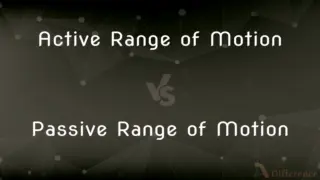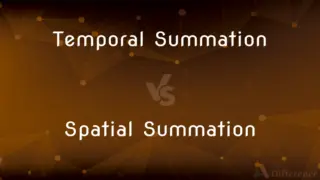Sense Strand of DNA vs. Antisense Strand of DNA — What's the Difference?
Edited by Tayyaba Rehman — By Fiza Rafique — Published on December 12, 2023
The Sense Strand of DNA has the same sequence as mRNA, while the Antisense Strand of DNA serves as a template for mRNA synthesis.

Difference Between Sense Strand of DNA and Antisense Strand of DNA
Table of Contents
ADVERTISEMENT
Key Differences
The Sense Strand of DNA, often termed the "coding" strand, corresponds in sequence (with T replaced by U) to the mature form of mRNA that is translated into protein. The Antisense Strand of DNA, on the other hand, is utilized during transcription to produce a complementary RNA transcript.
In molecular biology, while the Sense Strand of DNA doesn't directly serve as a template for transcription, it provides an indication of the protein-coding sequence. The Antisense Strand of DNA, conversely, binds to the RNA polymerase and is read from 3' to 5', producing an RNA transcript.
The naming of these strands comes from the perspective of RNA. The Sense Strand of DNA shares its sequence with the mRNA (except for Thymine and Uracil differences). The Antisense Strand of DNA, however, is complementary to the mRNA sequence and doesn't resemble the final mRNA product.
Biologically, the function of the Sense Strand of DNA is to maintain the integrity of the genetic information as it mirrors the mRNA sequence. In contrast, the Antisense Strand of DNA provides the necessary template for synthesizing this mRNA during the transcription process.
It's worth noting that not all regions of the Sense Strand of DNA correspond to expressed genes or proteins. Still, its sequence gives a representation of the potential protein product. The Antisense Strand of DNA, meanwhile, ensures accurate and faithful transcription of genetic data into functional RNA molecules.
ADVERTISEMENT
Comparison Chart
Relation to mRNA
Matches mRNA sequence (T replaced by U)
Complementary to mRNA sequence
Function in Transcription
Not used as a direct template
Serves as the template
Sequence Reading
5' to 3' direction
3' to 5' direction (by RNA polymerase)
Terminology Origin
Resemblance to mRNA sequence
Complementarity to mRNA sequence
Direct Role in Protein Synthesis
Indicative of protein sequence
Does not resemble final mRNA product
Compare with Definitions
Sense Strand of DNA
The strand opposite the one that RNA polymerase reads.
The Sense Strand of DNA remains unaltered during the transcription process.
Antisense Strand of DNA
Opposite in sequence to the Sense Strand of DNA.
If you know the sequence of the Sense Strand of DNA, you can predict the Antisense Strand of DNA's sequence.
Sense Strand of DNA
The DNA strand with a sequence identical to the mRNA.
In gene expression, the Sense Strand of DNA serves as a reference but is not transcribed.
Antisense Strand of DNA
Also termed the "template" strand in transcription.
The Antisense Strand of DNA dictates the sequence of the produced RNA.
Sense Strand of DNA
The strand not used as a template during transcription.
Despite its name, the RNA polymerase doesn't read the Sense Strand of DNA.
Antisense Strand of DNA
The DNA strand used as a template for mRNA synthesis.
The RNA polymerase attaches to the Antisense Strand of DNA during transcription.
Sense Strand of DNA
The 5' to 3' oriented strand mirroring the mRNA's coding sequence.
The Sense Strand of DNA resembles the genetic information that will be translated into protein.
Antisense Strand of DNA
The strand complementary to the mRNA sequence.
The Antisense Strand of DNA provides the necessary information for creating an accurate mRNA transcript.
Sense Strand of DNA
Also known as the coding strand because of its likeness to mRNA.
Comparing the Sense Strand of DNA and its corresponding mRNA reveals only T-to-U variations.
Antisense Strand of DNA
The 3' to 5' oriented strand that RNA polymerase reads.
When creating RNA, the polymerase traverses the Antisense Strand of DNA.
Common Curiosities
Does the Antisense Strand of DNA match the mRNA sequence?
No, it's complementary to the mRNA sequence.
How does the Antisense Strand of DNA function in transcription?
It serves as the template for RNA synthesis.
Which strand is read by RNA polymerase?
The Antisense Strand of DNA.
Why is the Sense Strand of DNA also termed the "coding" strand?
Because its sequence mirrors that of the mature mRNA.
If I know the sequence of the Sense Strand of DNA, can I predict the Antisense strand?
Yes, the Antisense strand is complementary to the Sense strand.
What is the Sense Strand of DNA?
It's the DNA strand with a sequence identical to the mRNA, except for Thymine replaced by Uracil.
Is the entire Sense Strand of DNA always translated into protein?
No, only the regions corresponding to expressed genes.
Why is the Antisense Strand of DNA important for gene expression?
It ensures accurate transcription of genes into mRNA.
Is every Sense Strand of DNA actively transcribed in a cell?
No, only specific regions are transcribed based on cellular needs.
Which strand, the Sense or Antisense, directly correlates to the final protein sequence?
The Sense Strand of DNA gives an indication of the potential protein sequence.
Which strand, Sense or Antisense, contains the start codon?
The Sense Strand of DNA contains the start codon.
Do both strands, Sense and Antisense, have the same directionality?
No, they run in opposite directions, with the Sense strand being 5' to 3' and the Antisense strand being 3' to 5'.
Can mutations in the Antisense Strand of DNA affect protein function?
Yes, since it serves as the template for mRNA synthesis.
What happens if there's a mutation on the Sense Strand of DNA?
It could potentially alter the corresponding mRNA and protein product, impacting function.
How is the Sense Strand of DNA different from the produced mRNA?
The sequences are nearly identical, but Thymine in DNA is replaced by Uracil in mRNA.
Share Your Discovery

Previous Comparison
Active Range of Motion vs. Passive Range of Motion
Next Comparison
Temporal Summation vs. Spatial SummationAuthor Spotlight
Written by
Fiza RafiqueFiza Rafique is a skilled content writer at AskDifference.com, where she meticulously refines and enhances written pieces. Drawing from her vast editorial expertise, Fiza ensures clarity, accuracy, and precision in every article. Passionate about language, she continually seeks to elevate the quality of content for readers worldwide.
Edited by
Tayyaba RehmanTayyaba Rehman is a distinguished writer, currently serving as a primary contributor to askdifference.com. As a researcher in semantics and etymology, Tayyaba's passion for the complexity of languages and their distinctions has found a perfect home on the platform. Tayyaba delves into the intricacies of language, distinguishing between commonly confused words and phrases, thereby providing clarity for readers worldwide.












































